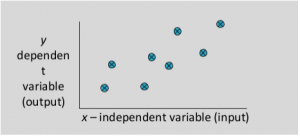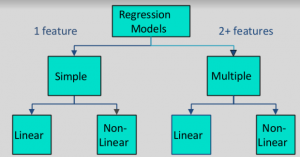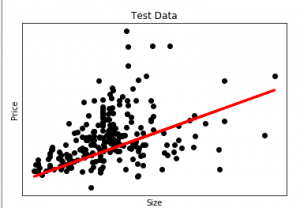Java Weka Time Series Classification Example
What is Regression and Classification in Machine Learning?
Data scientists use many different kinds of machine learning algorithms to discover patterns in big data that lead to actionable insights. At a high level, these different algorithms can be classified into two groups based on the way they "learn" about data to make predictions: supervised and unsupervised learning.

Supervised Machine Learning : The majority of practical machine learning uses supervised learning. Supervised learning is where you have input variables (x) and an output variable (Y) and you use an algorithm to learn the mapping function from the input to the output Y = f(X) . The goal is to approximate the mapping function so well that when you have new input data (x) that you can predict the output variables (Y) for that data.
Techniques of Supervised Machine Learning algorithms include linear and logistic regression, multi-class classification, Decision Trees and support vector machines. Supervised learning requires that the data used to train the algorithm is already labelled with correct answers. For example, a classification algorithm will learn to identify animals after being trained on a dataset of images that are properly labelled with the species of the animal and some identifying characteristics.
Supervised learning problems can be further grouped into Regression and Classification problems. Both problems have a goal of the construction of a succinct model that can predict the value of the dependent attribute from the attribute variables. The difference between the two tasks is the fact that the dependent attribute is numerical for regression and categorical for classification.
Regression
A regression problem is when the output variable is a real or continuous value, such as "salary" or "weight". Many different models can be used, the simplest is the linear regression. It tries to fit data with the best hyper-plane which goes through the points.

Types of Regression Models:

For Examples:
Which of the following is a regression task?
- Predicting age of a person
- Predicting nationality of a person
- Predicting whether stock price of a company will increase tomorrow
- Predicting whether a document is related to sighting of UFOs?
Solution : Predicting age of a person (because it is a real value, predicting nationality is categorical, whether stock price will increase is discrete-yes/no answer, predicting whether a document is related to UFO is again discrete- a yes/no answer).
Let's take an example of linear regression. We have a Housing data set and we want to predict the price of the house. Following is the python code for it.
Python3
import matplotlib
matplotlib.use( 'GTKAgg' )
import matplotlib.pyplot as plt
import numpy as np
from sklearn import datasets, linear_model
import pandas as pd
df = pd.read_csv( "Housing.csv" )
Y = df[ 'price' ]
X = df[ 'lotsize' ]
X = X.values.reshape( len (X), 1 )
Y = Y.values.reshape( len (Y), 1 )
X_train = X[: - 250 ]
X_test = X[ - 250 :]
Y_train = Y[: - 250 ]
Y_test = Y[ - 250 :]
plt.scatter(X_test, Y_test, color = 'black' )
plt.title( 'Test Data' )
plt.xlabel( 'Size' )
plt.ylabel( 'Price' )
plt.xticks(())
plt.yticks(())
regr = linear_model.LinearRegression()
regr.fit(X_train, Y_train)
plt.plot(X_test, regr.predict(X_test), color = 'red' ,linewidth = 3 )
plt.show()
The output of the above code will be:

Here in this graph, we plot the test data. The red line indicates the best fit line for predicting the price. To make an individual prediction using the linear regression model:
print( str(round(regr.predict(5000))) )
Classification
A classification problem is when the output variable is a category, such as "red" or "blue" or "disease" and "no disease". A classification model attempts to draw some conclusion from observed values. Given one or more inputs a classification model will try to predict the value of one or more outcomes.
For example, when filtering emails "spam" or "not spam", when looking at transaction data, "fraudulent", or "authorized". In short Classification either predicts categorical class labels or classifies data (construct a model) based on the training set and the values (class labels) in classifying attributes and uses it in classifying new data. There are a number of classification models. Classification models include logistic regression, decision tree, random forest, gradient-boosted tree, multilayer perceptron, one-vs-rest, and Naive Bayes.
For example :
Which of the following is/are classification problem(s)?
- Predicting the gender of a person by his/her handwriting style
- Predicting house price based on area
- Predicting whether monsoon will be normal next year
- Predict the number of copies a music album will be sold next month
Solution : Predicting the gender of a person Predicting whether monsoon will be normal next year. The other two are regression.
As we discussed classification with some examples. Now there is an example of classification in which we are performing classification on the iris dataset using RandomForestClassifier in python. You can download the dataset from Here
Dataset Description
Title: Iris Plants Database Attribute Information: 1. sepal length in cm 2. sepal width in cm 3. petal length in cm 4. petal width in cm 5. class: -- Iris Setosa -- Iris Versicolour -- Iris Virginica Missing Attribute Values: None Class Distribution: 33.3% for each of 3 classes
Python3
import pandas as pd
from sklearn.model_selection import train_test_split
from sklearn.ensemble import RandomForestClassifier
from sklearn.preprocessing import LabelEncoder
from sklearn.metrics import confusion_matrix
from sklearn.metrics import accuracy_score
from sklearn.metrics import classification_report
dataset = pd.read_csv(
'databases/iris/iris.data' ,sep = ',' , header = None )
data = dataset.iloc[:, :]
print ( "Sum of NULL values in each column. " )
print (data.isnull(). sum ())
X = data.iloc[:, : - 1 ].values
y = dataset.iloc[:, 4 ].values
labelencoder_y = LabelEncoder()
y = labelencoder_y.fit_transform(y)
X_train, X_test, y_train, y_test = train_test_split(
X, y, test_size = 0.3 , random_state = 0 )
classifier = RandomForestClassifier()
classifier = classifier.fit(X_train,y_train)
predicted = classifier.predict(X_test)
print ( 'Confusion Matrix :' )
print (confusion_matrix(y_test, predicted))
print ( 'Accuracy Score :' ,accuracy_score(y_test, predicted))
print ( 'Report : ' )
print (classification_report(y_test, predicted))
Output:
Sum of NULL values in each column. 0 0 1 0 2 0 3 0 4 0 Confusion Matrix : [[16 0 0] [ 0 17 1] [ 0 0 11]] Accuracy Score : 97.7 Report : precision recall f1-score support 0 1.00 1.00 1.00 16 1 1.00 0.94 0.97 18 2 0.92 1.00 0.96 11 avg/total 0.98 0.98 0.98 45
References:
- https://machinelearningmastery.com/logistic-regression-for-machine-learning/
- https://machinelearningmastery.com/linear-regression-for-machine-learning/
montgomerytherimand38.blogspot.com
Source: https://www.geeksforgeeks.org/regression-classification-supervised-machine-learning/
0 Response to "Java Weka Time Series Classification Example"
Post a Comment